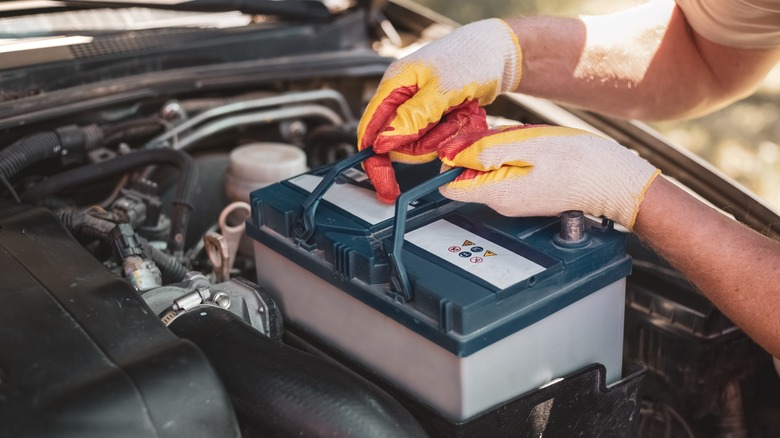5 Worst Ford Recalls In Recent Years (And How To Know If Your Car Is Affected)
Ford has issued some serious recalls in just the past few years due to issues like engine failure, unresponsive windshield wipers, fuel leaks with fire risk, power windows pinching occupants, and electrical malfunctions due to inadequate battery charge. But why are all these deficiencies surfacing across a wide range of models?
The auto industry has become increasingly more complex over the years, with advancements in diagnostics, safety, and driver assistance systems, to name a few. Not only are vehicle models more sophisticated, but automakers are constantly trying to reduce production time. A more streamlined factory process, automation implementation, and standardized operating procedures help reduce financial overhead.
However, a more complex vehicle on a tighter manufacturing schedule will inevitably end up with some recalls. According to Forbes, the average car is estimated to receive 3.2 recalls over a span of three decades. Some recalls are more severe than others, as made evident by chilling examples of the deadliest car recalls in history. Fortunately, if you navigate online to Ford.com/support/recalls/, you can search for any issues affecting your vehicle.
2.7-liter and 3.0-liter engine failure
Recently, a major problem was discovered across six different models, specifically the 2.7-liter and 3.0-liter engines utilized in the Ford and Lincoln lineup. A large recall affecting around 91,000 vehicles was issued due to defective intake valves.
Intake valves are vital components that introduce a mixture of oxygen and fuel into the cylinder, facilitating energy-generating combustion. Unfortunately, the automaker has identified potential irregularities with the intake valves in these select engines, which could cause them to break apart and tumble into the cylinder during operation.
If you own a 2021 or 2022 F-150, Edge, Explorer, or Bronco from Ford with either a 2.7-liter or 3.0-liter engine, you should immediately take your vehicle to the nearest dealer for inspection and testing. This issue also affects a few Lincoln models, like the Nautilus and Aviator, which include the same setup under the hood.
Windshield wiper malfunction
Visibility is critical when driving down the road. Weather can be unpredictable, and life doesn't pause for rainstorms or blizzards, so your wipers are essential to arrive safely at your destination. Considering it's a matter of safety, you should replace your windshield wipers often, especially if you notice signs of wear and tear.
However, Ford has reported that certain front wiper motors can fail to engage, leaving you with potentially zero forward visibility in certain circumstances. With over 37,000 possible vehicles affected, certain Ford models have an elevated risk of accidents during inclement weather. The vehicles susceptible to this issue include the 2023 to 2024 Maverick, 2023 Ford Bronco Sport, and the 2023 Mustang Mach-E. Fortunately, if you own one of these Fords, your local dealer can test the windshield wiper motor. If it's determined to be a risk, they can swap it out for a new part.
Gas leaks and potential fire risk
Gasoline can be dangerous. Vehicles are designed to carefully contain fuel within the system to prevent potential hazards, including dangerous fumes. However, Ford is recalling almost 43,000 of its SUVs due to a fuel leak within the engine. The fuel injectors, which are responsible for vaporizing and spraying fuel into the cylinder, can leak in certain models. When fuel touches high-temperature engine components (which it's not supposed to come into contact with), the end result can be a fire.
The automaker discovered the issue in its 1.5-liter engines, which are present in 2022 and 2023 Escapes and Bronco Sports. Rather than repairing the fuel injector leaks, Ford dealerships will affix a special hose to the area that should direct leaked gasoline away from hot components on the engine and toward the ground below the vehicle. Ford will also use a software update to help detect this problem and take action by lowering engine output to help control hot temperatures under the hood.
Power windows fail to detect obstructions
Powered windows were originally launched in 1940 as a premium upgrade and have all but taken over the automotive industry. To automatically raise or lower your car window, these systems rely on several sensors that detect when the glass has reached its upper or lower limit or if something is blocking the window from moving, such as an arm, for example.
If a power window system doesn't react to objects in the way of its path, it doesn't meet the safety requirements put in place by the Federal Motor Vehicle Safety Standards. Ford is recalling what could end up being over 70,000 vehicles, including the 2024 Ranger and 2024 Lincoln Nautilus, due to a power window system that won't automatically retract upon encountering an obstacle. In order to prevent possible pinching injuries, the modules within the front doors need a software update performed by the dealership.
Low battery charge causes electrical and engine problems
Your vehicle's battery not only provides the energy needed to start the ignition, but it also protects surges from negatively affecting the PCM (Power Control Module). Ford identified a low battery charge in more than 450,000 of its vehicles, which could cause electrical system malfunctions and loss of engine power. Safety is a factor, as this issue can disable emergency lights and suddenly reduce engine output during operation, leading to a potential accident.
This problem affects 2021 through 2024 Bronco Sport models and 2022 through 2023 Maverick trucks. Luckily, if you own one of these vehicles, Ford has a solution. Dealer service technicians just need to adjust two modules that pertain to body control and power train operations. If your Ford isn't listed among the models affected by this issue, but your car battery keeps dying, there are several possible reasons and steps to take to help prevent further problems.





